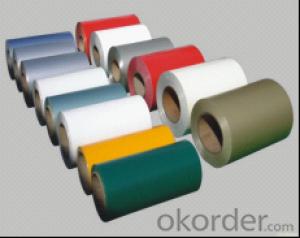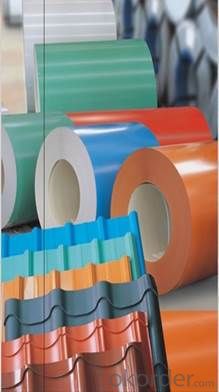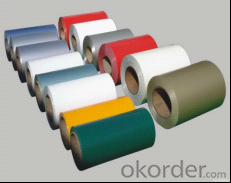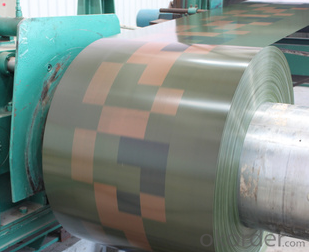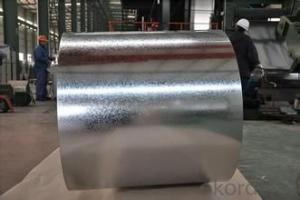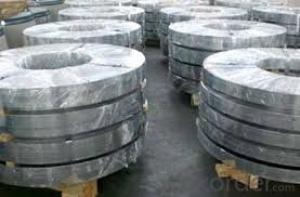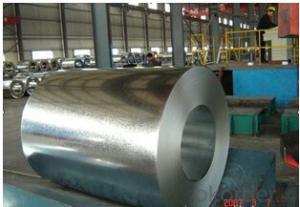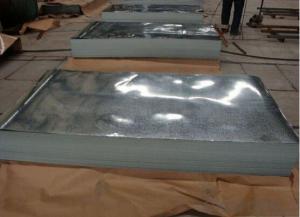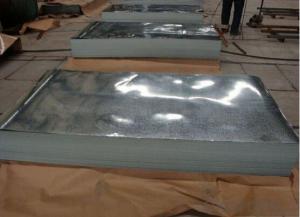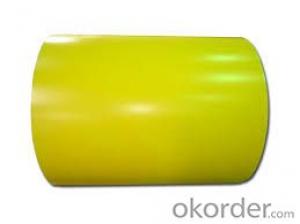Color coated galvanized Steel Coils/Sheets from China
- Loading Port:
- China main port
- Payment Terms:
- TT OR LC
- Min Order Qty:
- 1 m.t.
- Supply Capability:
- 100000000 m.t./month
OKorder Service Pledge
OKorder Financial Service
You Might Also Like
1) AVAILABLE DESIGNATION OF (Prepainted galvanized steel coils) printed PPGI coils
Quality Q/BQB 440-2003 JIS G3312-1994 EN 10326-2004 ASTM A653-02a
EN 10327-2004 (BASE PLATE)
(BASE PLATE)
Commercial Steel TDC51D CGCC DX51D+Z/AZ CS Type A/B/C
Forming Steel (TSt01,TSt02,TSt03) CGCD1 FS Type A, Type B
Drawing TDC52D /TDC53D - DX52D+Z/AZ DDS TYPE A/C
Steel DX53D+Z/AZ
Structural TS280GD(TStE28) CGC400 S280D+Z/AZ SS275
Steel TS350GD(TStE34) CGC440 S350D+Z/AZ SS340 Class1
2) OUR SPECIFICATION OF (Prepainted galvanized steel coils) printed PPGI coils
Available Size:
Manufacturer Thickness Width Length of plate Inner diameter of coil
JIANGSU HUIYE STEEL SHEET CO.,LTD 0.2-1.2mm 800/914/1000/1200/1219/1250mm 1000-6000mm 508mm/610mm
Coated Mass OF (Prepainted galvanized steel coils) printed PPGI coils:
Base plate Available Coated Mass(g/m^2)
Galvanized Steel 80, 100, 120, 160, 180
Galvalume Steel 50, 70, 150
Available Painting OF (Prepainted galvanized steel coils) printed PPGI coils:
Category of Painting Item Code
Polyester PE
High-durability polyester HDP
Silicon modified polyesters SMP
Polyvinylidene fluoride PVDF
Easy-Cleaning —
Painting Thickness Top side: 20+5microns;
Bottom side: 5~7microns.
Color System Produce according to RAL Color System or as per buyer’s color sample.
Painting structure Top surface Bottom surface
Primer coating No coating 1/0
Primer coating Primer coating 1/1
Primer coating + Finish coating No coating 2/0
Primer coating + Finish coating Primer coating or single back coating 2/1
Primer coating + Finish coating Primer coating + Finish back coating 2/2
- Q: How do steel sheets perform in terms of vibration resistance?
- Steel sheets generally offer good vibration resistance due to their high stiffness and density. The inherent properties of steel, such as its strong and rigid structure, enable it to dampen vibrations effectively. Steel sheets have high natural frequencies, which means they can resist a wide range of vibrations and minimize the amplification of vibrations that may occur in other materials. Additionally, steel sheets can be further enhanced with various techniques, such as adding damping materials or using special coatings, to improve their vibration resistance even more. Overall, steel sheets are considered to be a reliable choice when it comes to applications requiring vibration resistance.
- Q: Are the steel sheets resistant to graffiti or vandalism?
- Yes, steel sheets are typically resistant to graffiti and vandalism due to their durable and non-porous surface, making it difficult for paint or markers to adhere to them.
- Q: How do steel sheets perform in terms of electrical resistance?
- Steel sheets typically have relatively high electrical resistance compared to other materials. This means that they do not conduct electricity as easily as metals like copper or aluminum. The electrical resistance of steel sheets can vary depending on factors such as the composition and thickness of the sheet. In general, steel sheets are considered to be a poor conductor of electricity. However, it is important to note that electrical resistance can be reduced by applying certain coatings or treatments to the steel surface.
- Q: Can steel sheets be galvanized or coated with protective layers?
- Yes, steel sheets can be galvanized or coated with protective layers. Galvanizing is a process of applying a protective zinc coating to steel to prevent it from rusting. This is achieved by either hot-dip galvanizing, where the steel sheet is immersed in a bath of molten zinc, or by electroplating, which involves applying a zinc coating through an electrolytic process. In addition to galvanizing, steel sheets can also be coated with various protective layers. These coatings can include paint, epoxy, powder coatings, or other specialized coatings designed to enhance resistance to corrosion, chemicals, or abrasion. These protective coatings not only provide an aesthetic appeal but also serve as a barrier against environmental factors that could potentially damage the steel. The choice of galvanizing or coating a steel sheet depends on the specific application and the level of protection required. Galvanizing offers excellent corrosion resistance and is commonly used in outdoor applications where the steel is exposed to moisture, such as construction, automotive, and infrastructure industries. Coatings, on the other hand, provide a wide range of protective properties, making them suitable for various applications, including indoor environments or where specific chemical resistance is required. Ultimately, both galvanizing and coating steel sheets with protective layers are effective methods to enhance their durability and prolong their lifespan. The selection of the appropriate method depends on factors such as the intended use, environmental conditions, and budget.
- Q: Are steel sheets suitable for solar panel mounting?
- Yes, steel sheets are suitable for solar panel mounting. Steel is a strong and durable material that can provide a sturdy base for solar panels. It is resistant to rust and corrosion, making it ideal for outdoor installations. Steel sheets can be easily fabricated into various shapes and sizes to accommodate different solar panel configurations. Additionally, steel is readily available and cost-effective, making it a popular choice for solar panel mounting systems. Overall, steel sheets offer the necessary strength, stability, and longevity required for supporting solar panels effectively.
- Q: Can steel sheets be used for chimneys and flue systems?
- No, steel sheets are not suitable for chimneys and flue systems as they can corrode and deteriorate rapidly due to the high temperatures and corrosive gases generated by the combustion process. It is recommended to use materials specifically designed for chimneys and flue systems, such as stainless steel or ceramic.
- Q: Can steel sheets be used in food processing industries?
- Yes, steel sheets can be used in food processing industries. Stainless steel sheets are commonly used in food processing industries due to their many beneficial properties. Stainless steel is resistant to corrosion, which is essential in an environment where food is processed, as it prevents contamination and ensures the safety of the final product. Steel sheets are also easy to clean and maintain, making them ideal for use in industries where hygiene is of utmost importance. Additionally, stainless steel is non-reactive to food, meaning it does not leach any harmful chemicals into the processed food. Steel sheets are versatile and can be used for various applications in food processing industries, such as countertops, worktables, shelving, and equipment surfaces.
- Q: What is the average yield strength of steel sheets?
- The average yield strength of steel sheets can vary depending on the specific grade and thickness of the steel being used. However, as a general range, the average yield strength of steel sheets typically falls between 250 and 600 megapascals (MPa). It is important to note that different steel grades, such as mild steel, high-strength low-alloy (HSLA) steel, or stainless steel, will have different average yield strengths. Additionally, the thickness of the steel sheet can also impact its yield strength, with thinner sheets generally having higher yield strengths. Therefore, it is crucial to consult the specifications and standards provided by the manufacturer or industry guidelines to determine the specific average yield strength for a particular steel sheet.
- Q: What is the average cost of stainless steel sheets?
- The average cost of stainless steel sheets can vary depending on factors such as size, thickness, grade, and market conditions. However, as of 2021, the average cost ranges from $30 to $150 per square foot.
- Q: Can steel sheets be used for cladding or facade systems?
- Yes, steel sheets can be used for cladding or facade systems. Steel sheets offer durability, strength, and a sleek appearance, making them suitable for various architectural applications including cladding or facade systems. They can be customized in terms of color, finish, and shape, allowing for versatile design possibilities. Additionally, steel sheets provide weather and fire resistance, making them a reliable choice for exterior applications.
Send your message to us
Color coated galvanized Steel Coils/Sheets from China
- Loading Port:
- China main port
- Payment Terms:
- TT OR LC
- Min Order Qty:
- 1 m.t.
- Supply Capability:
- 100000000 m.t./month
OKorder Service Pledge
OKorder Financial Service
Similar products
Hot products
Hot Searches
Related keywords


